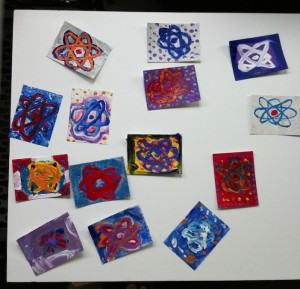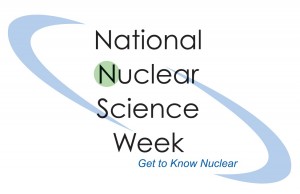In preparation for this year’s Nuclear Science Week, I did a lot of reflecting about where nuclear technologies intersect with our daily lives. From medicine to agriculture, to manufacturing and energy, this process has been a valuable reminder of why we need nuclear technologies to begin with and why we’ve rapidly integrated them into our lives since their discovery only about a century ago.
If all of our nuclear technologies disappeared tomorrow, we’d have space missions go silent, patients suffering needlessly, and we’d lose one of our greatest tools in the effort to mitigate climate change. Along with the myriad of practical and unique uses of nuclear technologies, there is an equally important responsibility to mitigate the more sinister uses of these technologies and their waste streams. Ethical and moral judgments are a substantial part of the fabric of the nuclear story.
My little slice of this responsibility lies in the communication of essential information about nuclear technologies with the public, and I work to do this in an evidence-based, ethical, and emotionally sensitive way.
It probably doesn’t need saying, but nuclear is a polarizing issue. Part of my goal is to help depolarize the issue enough to have the sometimes tough, but important conversations about how to leverage nuclear technologies to do the most good, while simultaneously being responsible about waste management and nonproliferation. Coming at this enormous challenge in a holistic way is not easy. There’s a lot of nuance and patience and listening involved, and even then I count the smallest of positive interactions as big wins.
Interestingly, and perhaps not surprisingly, since Fukushima, there has been an influx of social scientists and risk perception experts looking very closely at nuclear technologies, which have made me rethink many of my methods of communication. I want to delve into some of the key findings of an article that looks specifically at the intersection of nuclear technologies and public emotions.
Recently published in the Journal of Risk Research, “Nuclear Energy, Responsible Risk Communication and Moral Emotions: A Three Level Framework” (by Jessica Nihlen Fahlquist and Sabine Roeser) makes an evidence-based case for the need for empathy and emotional consideration in nuclear communications.
As a science communicator, it felt good to have confirmation that understanding and responding to others emotions is not naïve, but is actually critical to effective risk communication. The authors go so far as to suggest that it is in fact an ethical imperative. Here is an expert that outlines why emotions matter and must be considered in decision making processes:
Emotions play an important role in public risk perception (Slovic 2010). However, emotions are usually seen as an obstacle to sound decision-making and communication about risks (Sunstein 2005). At most, emotions are seen as a potential tool for manipulation, which is why emotions are often endorsed by marketing experts and eschewed by those who are looking for criteria for responsible risk communication. These views are based on the idea that emotions are irrational gut reactions, i.e. suggesting a dichotomy between rationality and emotions (e.g. Haidt 2001). However, developments in emotion research show that this is a false dilemma, based on an overly simplistic conception of emotions. Emotion scholars from philosophy and psychology have shown that emotions are not opposed to rationality, knowledge and cognition, but they are a form of practical, moral rationality and that they have cognitive and affective aspects (Scherer 1984; Frijda 1987; Lazarus 1991; Solomon 1993; Nussbaum 2001; Roberts 2003; Zagzebski 2003). Neuropsychological research by Damasio shows that people without emotions but intact rationality have impaired capacities for decision-making when it comes to concrete practical and moral judgements, and concerning judgements about acceptable risk (Damasio 1994). Decision-making about technological risks is not only a matter of technical, scientific expertise, but also involves an ethical assessment (Shrader-Frechette 1991; Hanson 2004; Asveld and Roeser 2009). Technologies and risks are inherently value laden (Verbeek 2011; Möller 2012). Emotions such as sympathy, compassion and feelings of responsibility help to draw our attention to moral aspects of risks such as justice, fairness and autonomy (Roeser 2006, 2009, 2010a, 2010b). Including moral values, virtues and emotions does not threaten the objectivity of risk; rather, they are required for a proper appreciation of risk (Roeser 2006; Athanassoulis and Ross 2010; Hansson 2010; Hermansson 2012). These ideas can shed important new light on morally responsible risk communication (Roeser 2012b; Roeser and Nihlén Fahlquist 2013). In the following sections, we will explore how moral emotions can contribute to ethically responsible communication about the risks of nuclear energy.
I strongly suggest reading the whole paper for an excellent breakdown of how we can start to better incorporate concern for emotion into communication strategies for nuclear technologies. A significant part of the paper focuses on how to build legitimate processes and procedures for engaging stakeholders, but within those concepts there is an enormous amount of information that is valuable for any individual who works on and/or communicates about nuclear technologies, or really any contentious technology for that matter.
A complement to reading Moral Emotions is one of my go-to studies on trust, “The Universal Dimensions of Social Cognition: Warmth and Competence.”
For many years, the nuclear community has relied on self-reported data about trust. Essentially, when asked directly, most folks will say they trust a scientist over an activist, an engineer over a celebrity. It seems that we all think that we are excellent judges of character and information. At face value, it seems obvious that we should encourage members of the scientific community to put themselves out there and share what they know, right? Well, not exactly. As it turns out, self-reported data is really good for some things, like finding out our favorite color or sports team, and not so great for other things, like understanding how we judge others and determine trust.

Student-created artwork. Educating young people about nuclear issues is a crucial part of building bridges of nuclear communication and trust. Photo courtesy of Suzy Baker
The “Universal Dimensions of Social Cognition” suggests that we really determine who we trust based on the intersection of a person’s warmth and competence. That said, warmth is primary, and again connected to moral judgment:
Although warmth and competence dimensions emerge consistently, considerable evidence suggests that warmth judgments are primary: warmth is judged before competence, and warmth judgments carry more weight in affective and behavioral reactions. From an evolutionary perspective, the primacy of warmth is fitting because another person’s intent for good or ill is more important to survival than whether the other person can act on those intentions. Similarly, morality (warmth) judgments determine approach–avoidance tendencies, so they are the fundamental aspect of evaluation [8,9] and, therefore, precede competence–efficacy judgments. People infer warmth from the perceived motives of the other person [10].
So if we want scientists and other technical folks to succeed at communicating their ideas we need to make sure they are primed to build trust with their audience by cultivating warmth. Simply being a scientist or technical expert isn’t enough to establish trust. I’ve often described warmth as a transmission line— you must build the connection before you can transfer information.
To quote Fahlquist and Roeser again: “A successful risk communication effort triggers reflection, compassion and a willingness to take responsibility for energy-related issues.” The best way to bring these moral emotions to the conversation is to cultivate them within ourselves, well before we begin communicating risks with others.
As we move forward with advanced nuclear technologies, waste management plans and other sophisticated technical solutions in the nuclear sector, we need to establish equally advanced and sophisticated risk communications strategies.
Featured Image Source: nuclearscienceweek.org



